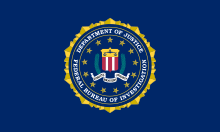National Incident Based Reporting System
| Federal Bureau of Investigation | |||||||||||||||||||||||||||||||||||||||||||||||||||||||||||
|---|---|---|---|---|---|---|---|---|---|---|---|---|---|---|---|---|---|---|---|---|---|---|---|---|---|---|---|---|---|---|---|---|---|---|---|---|---|---|---|---|---|---|---|---|---|---|---|---|---|---|---|---|---|---|---|---|---|---|---|
| Common name | Federal Bureau of Investigation | ||||||||||||||||||||||||||||||||||||||||||||||||||||||||||
| Abbreviation | FBI | ||||||||||||||||||||||||||||||||||||||||||||||||||||||||||

|
|||||||||||||||||||||||||||||||||||||||||||||||||||||||||||
|
|||||||||||||||||||||||||||||||||||||||||||||||||||||||||||
| Notables | |
|---|---|
| People |
|
| Significant Operations | |
National Incident-Based Reporting System (NIBRS) is an incident-based reporting system used by law enforcement agencies in the United States for collecting and reporting data on crimes. Local, state and federal agencies generate NIBRS data from their records management systems. Data is collected on every incident and arrest in the Group A offense category. These Group A offenses are 49 offenses grouped in 23 crime categories. Specific facts about these offenses are gathered and reported in the NIBRS system. In addition to the Group A offenses, 10 Group B offenses are reported with only the arrest information.
Uniform Crime Reports (UCR) began in the late 1920s when the Committee on Uniform Crime Records, established by the International Association of Chiefs of Police (IACP) in 1927, published the first version of the Uniform Crime Reporting Handbook. With this initiative, the Uniform Crime Reports program began under the jurisdiction of the Federal Bureau of Investigation. Over the years, the uniform crime report developed into a broad utility for summary-based reporting of crimes. By the late 1970s, the law enforcement community saw the need for a more detailed crime reporting program that would meet the needs of law enforcement agencies in the 21st century.
Testing for the new NIBRS system began in South Carolina. The new system was approved for general use at a national UCR conference in March, 1988.
The general concepts, such as jurisdictional rules, of collecting and reporting SRS (Summary Reporting System) data are the same as in NIBRS. However, NIBRS goes into much greater detail than SRS. NIBRS includes 24 Group A crime categories whereas SRS only has 9 crime categories classified as Part I.
In NIBRS, the definition of rape has been expanded to include male victims. SRS, until recently, defined rape as "the carnal knowledge of a female forcibly and against her will" but since has been expanded. Formerly in SRS, sex attacks against males were to be classified only as either assaults or "other sex offenses", depending on the nature of the crime and the extent of the injury.
When multiple crimes are committed by a single person or group of persons during the same basic period of time and same basic location, SRS uses a "Hierarchy Rule" (see UCR for details) to determine which offenses will be reported for that incident. Only the most serious offense is reported. For example, if a criminal burglarizes a residence and assaults the inhabitant, only the assault is reported as it takes precedence over the burglary on the "Hierarchy Rule". NIBRS reports all offenses involved in a particular incident.
...
Wikipedia


